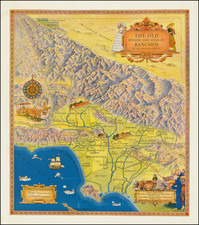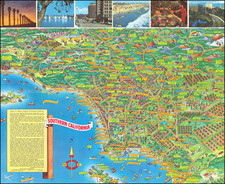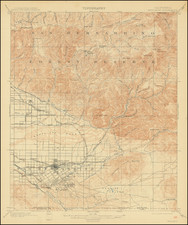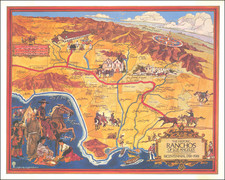Rare separately published map of the Interurban Routes in Los Angeles, published for the German-American Savings Bank of Los Angeles.
A fascinating color coded look at the various rail lines operating in the Los Angeles area. Lines shown include:
- Pacific Electric Ry (red)
- Los Angeles Interurban R. (green)
- Los Angeles & Redondo Ry (light blue)
- Los Angeles Pacific Ry (purple)
- Salt Lake RR (magenta)
- Santa Fe Ry (dark blue)
- Southern Pacific RR (yellow)
This remarkable large format map provides a remarkable snapshot of the development of Urban Transit in the Los Angeles Basin.
Interurban Railways of Los Angeles
Electric trolleys first traveled in Los Angeles in 1887. In 1895, The Pasadena and Pacific Railway was created from a merger of the Pasadena and Los Angeles Railway and the Los Angeles Pacific Railway (to Santa Monica). The Pasadena and Pacific Railway boosted Southern California tourism, living up to its motto "from the mountains to the sea."
The Pacific Electric Railroad was created in 1901 by railroad executive Henry Huntington and banker Isaias W. Hellman. As a Vice-President of the Southern Pacific Railroad, Henry Huntington had a solid background in electric trolley lines in San Francisco where he oversaw the Southern Pacific's effort to consolidate many smaller street railroads into one organized network. Hellman, the President of the Nevada Bank, became one of the largest bond holders for these lines. Hellman and Huntington developed a close business relationship. The success of their San Francisco trolley venture and Hellman's experience in financing some early Los Angeles trolley lines, led them to invest in the purchase of some existing downtown Los Angeles lines, which they in turn standardized and organized into a single network, called under the Los Angeles Railway.
In May 1901 Hellman, who had been Southern California's leading banker for almost three decades, wrote Huntington that "the time is at hand when we should commence building suburban railroads out of the city." In 1901, Huntington and Hellman incorporated a new entity, the Pacific Electric Railway, to construct these new electric rail lines to connect Los Angeles with surrounding cities. The syndicate began purchasing property and rights-of-ways. The new company's first main project, the line to Long Beach, opened for business in July 1902.
Huntington experienced a variety of opposition from organized labor efforts beginning with the construction of the new railways. Tensions between union leaders and other like minded Los Angeles business men were kept high from the early 1900s up through the 1920s. Strikes and boycotts troubled Pacific Electric throughout those years, until it reached a height of violence in the 1919 Streetcar Strike of Los Angeles.
Railroads were only one part of the enterprise. Revenue from passenger traffic was rarely enough to turn much, if any, profit. Freight traffic usually was profitable. The real money for the investors was in the supplying electric power to these new communities and in developing the neighboring real estate along the lines. To get railroads and electricity to their towns, local groups would offer the Huntington interests opportunities to acquire or partner in local land deals. Soon Huntington and his partners had significant holdings in the land companies developing Naples, Bay City (Seal Beach), Huntington Beach, Newport Beach and Redondo Beach.
By 1903, Huntington's insistence on reinvesting profits into costly expansion rather than paying any stockholder dividends led to tension with Hellman. As a result, the Hellman group sold a large part of their stock in the Pacific Electric to E.H. Harriman, making Harriman and Huntington equal partners. After an overnight trip to San Francisco, an arrangement was worked out between Harriman and Huntington. Huntington could expand the Pacific Electric as he saw fit, but he was not to compete with existing Southern Pacific lines.
Huntington continued to expand his railroad and not declare profits. After Huntington's purchase of the Redondo Railroad in 1905, the Hellman group sold the rest of their shares to Harriman, leaving the Pacific Electric in effective control of Harriman and the Southern Pacific.
The consolidation of lines into the Pacific Electric had continued. On March 19, 1906, an agreement was reached with Moses Sherman, owner of the Los Angeles Pacific Railroad lines, to sell the lines for $6 million to the Pacific Electric Railway, this turned over all the lines in Pasadena, San Fernando Valley and West LA, to the Pacific Electric.
Harriman continued to leave Huntington alone until 1910 when the Southern Pacific refused to allow the Pacific Electric to run a line to San Diego, that would compete with the Southern Pacific's existing line.
At this point, Huntington sold out all his Pacific Electric stock to Harriman and in what was called the "Great Merger" of 1911, the Southern Pacific and Pacific Electric basically became one single operation, with all electrical operations now under the Pacific Electric name. Huntington retained control of the Los Angeles Railway.
Following these acquisitions, Pacific Electric was the largest operator of interurban electric railway passenger service in the world, with 2,160 daily trains over 1,000 miles of track. It ran to destinations all over Southern California, particularly to the south and east.
Large profits from land development were generated along the routes of the new lines. Huntington Beach was incorporated in 1909 and developed by the Huntington Beach Company, a real-estate development firm owned by Henry Huntington, which still owns both land in the city and most of the mineral rights.
Rarity
This is the second example of the map we have offered in the past 3 decades (1992-2023).
We note an example at PBA Galleries in 2019.











![[ Mapping an Historic Rainfall Event in Southern California ] Isohyetal Map of Northwestern Part of Southern California Showing total precipitation, in inches, February 27 to March 4, 1938](https://storage.googleapis.com/raremaps/img/small/82484.jpg)
![[ Orange County / Wine Industry ] Residence of Theodore Reiser, Anaheim, Los Angeles Co., Cal.](https://storage.googleapis.com/raremaps/img/small/96403.jpg)



